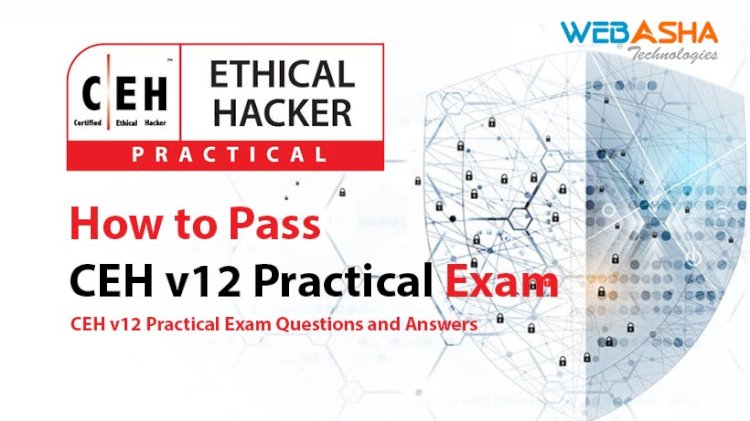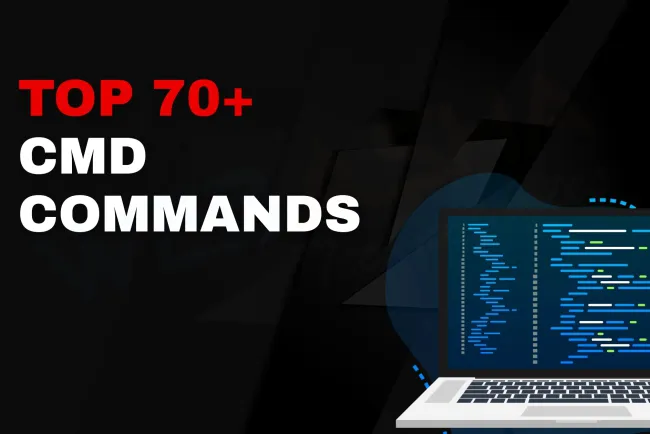How to Pass CEH Practical Exam | CEH v12 Practical Exam Questions and Answers
Want to pass the CEH v12 Practical Exam? This comprehensive guide from WebAsha Technologies provides CEH Practical Exam questions and answers, as well as tips and strategies to help you prepare and succeed on test day.

The Certified Ethical Hacker (CEH) is a globally recognized certification program offered by the International Council of E-Commerce Consultants (EC-Council). It is designed to help professionals and beginners gain expertise in the field of ethical hacking and penetration testing. One of the requirements for earning the CEH certification is passing the CEH Practical Exam. In this article, we will discuss how to pass the CEH Practical Exam, including some sample questions and answers, with the help of WebAsha Technologies.
Understanding the CEH Practical Exam: The CEH Practical Exam is a hands-on, performance-based exam that assesses a candidate’s ability to apply ethical hacking techniques in real-world scenarios. The exam is designed to test a candidate’s skills in identifying vulnerabilities, exploiting them, and documenting the findings in a professional report. The CEH Practical Exam is a six-hour exam, and it consists of 20 different scenarios, each of which requires the candidate to perform various ethical hacking tasks.
Tips to Pass the CEH v12 Practical Exam:
Understand the Exam Format:
Before starting your preparation, make sure you have a thorough understanding of the exam format. Familiarize yourself with the types of scenarios and the skills required to complete them.
Practice, Practice, Practice:
The key to success in the CEH Practical Exam is practice. Utilize different ethical hacking tools and techniques to gain practical experience. WebAsha Technologies offers comprehensive training and practice labs that simulate real-world scenarios to help you develop your skills.
Time Management:
Time management is crucial for success in the CEH Practical Exam. You must ensure that you allocate the appropriate amount of time for each scenario and avoid spending too much time on any one task.
Develop a Strategy:
Develop a strategy for tackling each scenario. Analyze the scenario, identify the objectives, and plan the necessary steps to achieve those objectives.
Document Your Work:
Proper documentation is critical for success in the CEH Practical Exam. You must keep track of your actions and record all your findings in a professional report.
Review and Refine:
After completing each scenario, review your work, and refine your approach. Analyze your mistakes and learn from them to improve your performance in subsequent scenarios.
CEH Practical Exam Sample Questions and Answers
Here are some sample questions and answers that may help you prepare for the CEH Practical Exam.
- Scenario: You have been hired by a financial institution to assess their network security. Your objective is to identify any vulnerabilities that could be exploited by an attacker.
Question: What tools and techniques would you use to assess the network security?
Answer: I would use a combination of port scanning tools like Nmap and vulnerability scanners like Nessus to identify any open ports and potential vulnerabilities. I would also conduct manual testing to identify any misconfigurations or weak passwords.
- Scenario: You have been hired by a manufacturing company to test their web application security. Your objective is to identify any vulnerabilities that could be exploited by an attacker.
Question: What tools and techniques would you use to test the web application security?
Answer: I would use a combination of tools like Burp Suite, OWASP ZAP, and Nikto to identify any vulnerabilities in the web application. I would also conduct manual testing to identify any injection vulnerabilities or other security issues.
- Scenario: You have been hired by a government agency to test their wireless network security. Your objective is to identify any vulnerabilities that could be exploited by an attacker.
Question: What tools and techniques would you use to test the wireless network security?
Answer: I would use tools like Aircrack-ng and Kismet to identify any open wireless networks and potential vulnerabilities. I would also conduct manual testing to identify any misconfigurations or weak encryption protocols.
Here are some more sample questions and answers to give you an idea of what to expect on the CEH practical exam:
Question 1: You have been asked to perform a vulnerability assessment on a web application. What tools and techniques would you use to accomplish this task?
Answer: To perform a vulnerability assessment on a web application, I would use a combination of manual techniques and automated tools. Some of the tools I might use include Nmap, Burp Suite, and OpenVAS. I would also manually review the web application's source code and perform a thorough analysis of the network infrastructure to identify any potential vulnerabilities.
Question 2: You have discovered a vulnerability on a network device. What steps would you take to remediate the vulnerability?
Answer: If I discovered a vulnerability on a network device, the first step I would take is to verify the vulnerability by performing additional testing and analysis. Once I had confirmed the vulnerability, I would work with the system owner to develop a remediation plan. This might involve patching the device, implementing additional security controls, or replacing the device altogether. I would also ensure that any necessary documentation and reporting was completed.
Question 3: You have been asked to perform a penetration test on a wireless network. What steps would you take to prepare for this task?
Answer: To prepare for a wireless network penetration test, I would first research the wireless technology being used to identify any known vulnerabilities or attack techniques. I would also acquire and configure any necessary equipment, such as wireless network adapters and antennas. Before beginning the penetration test, I would obtain written permission from the organization being tested and ensure that all legal and ethical considerations had been addressed. During the test, I would use a combination of manual techniques and automated tools to identify potential vulnerabilities and exploit them to gain access to the wireless network.
Question 4: Identify the IP address of the web server running on port 80.
Answer: Use Nmap to scan for open ports on the target system. Once you identify that port 80 is open, use a web browser to access the web server. The IP address of the web server will be displayed in the URL.
Question 5: Exploit a vulnerability in a web application to gain access to the system.
Answer: Use a web application vulnerability scanner such as Burp Suite or OWASP ZAP to identify vulnerabilities in the web application. Once you identify a vulnerability, use an exploit to gain access to the system.
Question 6: Capture network traffic and analyze it to identify sensitive information being transmitted in clear text.
Answer: Use Wireshark to capture network traffic. Look for information such as usernames, passwords, and other sensitive data being transmitted in clear text.
Question 7: Exploit a vulnerability in a Windows system to gain administrative access.
Answer: Use Metasploit to identify and exploit a vulnerability in the Windows system. Once you gain access to the system, escalate privileges to gain administrative access.
Question 8: Use social engineering to obtain sensitive information from an employee.
Answer: Social engineering involves using manipulation and deception to obtain sensitive information from an individual. Use techniques such as pretexting, phishing, and baiting to obtain the information.
In conclusion, passing the CEH practical exam requires a lot of preparation and practice. By following the tips and techniques outlined in this article, and by practicing with WebAsha Technologies' virtual lab environment, you can increase your chances of passing the exam on your first attempt. Remember to manage your time effectively, know the tools and technologies, and focus on documentation. Good luck!








![Get Discounted OSCP | OSCP+ Certification Exam Voucher [PEN-200]](https://www.webasha.com/blog/uploads/images/202501/image_650x434_67938aca2a833.webp)





![Top 10 Ethical Hackers in the World [2025]](https://www.webasha.com/blog/uploads/images/202408/image_100x75_66c2f983c207b.webp)








